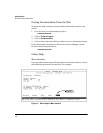
2-6
Introduction to IPv6
Use Model
Use Model
Adding IPv6 Capability
IPv6 was designed by the Internet Engineering Task Force (IETF) to improve
on the scalability, security, ease of configuration, and network management
capabilities of IPv4.
IPv6 provides increased flexibility and connectivity for existing networked
devices, addresses the limited address availability inherent in IPv4, and the
infrastructure for the next wave of Internet devices, such as PDAs, mobile
phones and appliances.
Where IPv4 networks exist today, IPv6 will be phased in over a period of years,
requiring an interoperability among the devices using the two protocols.
Beginning with software release K.13.01, the switches covered by this guide
offer IPv4/IPv6 dual stack operation. This allows full ethernet link support for
both IPv4 and IPv6 traffic to move on the same interface (VLAN) without
modifying current IPv4 network topologies. This enables you to use IPv6
devices on existing VLANs, manage the switch and other devices from IPv6
management stations, and create "islands" of IPv6 devices as needed to
accomodate the need for the IPv6 network growth anticipated for the future.
Supported IPv6 Operation in Release K.13.01
Software release K.13.01 provides IPv6 protocol and addressing to support
host-mode (endpoint) IPv6 operation, including basic layer-2 functionality.
IPv6 routing features are not available in this release. However, using a dual-
stack (IPv4/IPv6-capable) router, IPv6 traffic can be routed between VLANs
and sent across an IPv4 network to another IPv6 device.
(For general information on sending IPv6 traffic across an IPv4 network, refer
to “Connecting to Devices Supporting IPv6 Over IPv4 Tunneling” on page 2-5.)
The IPv6 features available in release K.13.01 belong to these general catego-
ries:
■ switch configuration and management
■ security
■ IPv6 multicast traffic
■ diagnostic and troubleshooting


















